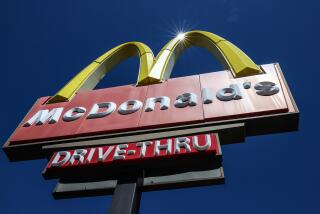Fast-food industry: healthy or just hanging on?
Ahead of planned picketing by fast-food workers seeking $15-an-hour minimum wage, experts are pondering whether McDonald’s, KFC and their quick-service ilk are strong enough to support such a drastic change.
Data from research group Sageworks suggests that fast-food eateries are in a strong financial position, enjoying a relatively high 4.6% profit margin. Between August 2012 and 2013, the segment grew sales at its highest rate since the recession, enjoying a 12.9% boost, according to the group.
Data compiled by Economic Modeling Specialists Intl. show that hiring of fast-food cooks and workers involved in food preparation and serving has increased in major metropolitan areas since the recession.
In the New York, Long Island and New Jersey region, which has the largest number of such employees, the headcount has grown 22.6% from 2007 to 160,728 workers.
The area that includes Los Angeles, Long Beach and Santa Ana is the next largest, with 155,641 workers – a 10.3% boost from 2007. The heartland district encompassing Chicago, Joliet and Naperville has seen an 8.2% jump to 100,724 workers.
Wall Street seems confident in the fast-food industry this year. So far, McDonald’s Corp. stock is up 9.2% while Yum Brands Inc., parent to Taco Bell and KFC, is up 9.1%. Burger King Worldwide Inc. is ahead 19.8%. The Wendy’s Co. has soared 63.6%.
Quiz: How well do you know fast food?
But Bonnie Riggs, an analyst with research firm NPD Group, says the outlook for the industry is grim.
“The restaurant industry is not doing all that well,” she said, noting that fast food makes up 78% of total restaurant visits. “Traffic is not increasing and has actually slowed down the last few months.”
High inflation in ingredient prices, as well as heavy discounting designed to lure patrons back into restaurants, has squeezed margins, Riggs said. Even then, consumers are trying to spend less when they dine out, refraining from beverages or appetizers.
McDonald’s has struggled to meet Wall Street expectations, reporting several quarters of disappointing earnings in the last two years. Chief Executive Donald Thompson told analysts recently that “results for the rest of the year are expected to remain challenged.”
Burger King drew strength from its foreign restaurants as same-store sales in the U.S. during the second quarter slid 0.5%. Chief Executive Daniel Schwartz said the slip was due in part to “the soft consumer spending environment, with increasing competitive pressures.”
NPD’s forecast for the restaurant industry doesn’t look promising, showing less than half a percent of growth annually over the next decade – sluggishness that Riggs attributes to the aging population and the unexpectedly long-lasting economic malaise.
The fast-food segment hasn’t shrunk since 2009, when it contracted 0.6%, but growth has slowed since it clocked a 2.9% expansion in 2010, according to research group IBISWorld. This year, the group projects a 0.5% bump up in revenue to $191 billion.
“During the recession, disposable income decreased and unemployment jumped, meaning consumers were forced to cut back on luxuries like eating out,” researcher Andy Brennan wrote in a report last month. “Additionally, as consumer eating habits changed, they became increasingly health conscious and demanded alternatives to traditional greasy fast-food options.”
But IBISWorld sees fast-food eateries catching a break in the next five years, with sales growing an average of 1.9% annually.
ALSO:
McDonald’s to roll out chicken Mighty Wings nationally
Chipotle, Panera, fast-casual chains continue restaurant reign
A sour economic signal: Wal-Mart misses expectations, cuts outlook







